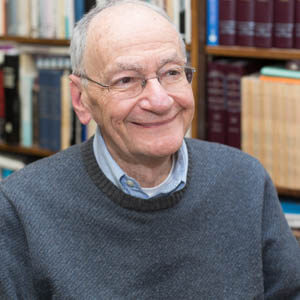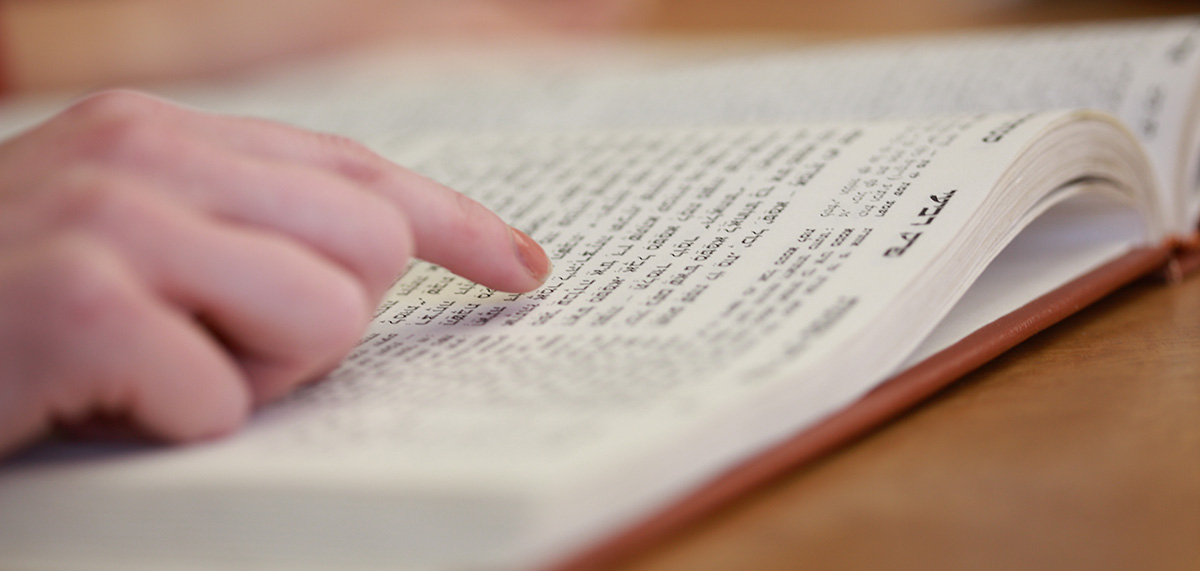Search Results
Back to JTS Torah Online's Main page
Joseph’s Three Encounters
Dec 17, 1999 By Matthew Berkowitz | Commentary | Vayiggash
Parashat Va-Yiggash opens with the dramatic encounter between Joseph and his older brother, Judah. Judah, who years earlier had cooperated with his brothers to betray Joseph, seems to be on the verge of losing his father’s other favored son, Benjamin, as well. Judah makes an impassioned plea to Joseph, offering himself as a hostage in Benjamin’s stead. As it turns out, Judah’s altruism is more than Joseph can withstand. While he was able to hold back and hide his identity numerous times, letting his brothers squirm in discomfort before the strange Egyptian man, this time is different. Joseph reveals his identity. The moment is one of closeness, of reconciliation, and of Joseph’s recognition that it was not his brothers’ deeds but rather God’s plan that had guided the events of his latter years.
Read More
Memory and Reconciliation
Dec 11, 1999 By Ismar Schorsch | Commentary | Miketz
What ought to be the role of memory in our lives is the conundrum that lies at the heart of this week’s parasha. Just how much of our experience is retained by us, or should be? Is mental health better served by remembering or forgetting? How deep must we dredge into the sediment of our minds to retain or regain the ability to function? A recent study of women on welfare, immune to the prescriptions of tough love, showed how many were once the victims of constant child abuse, which left untreated, impaired them for life. They needed to be healed before they could be restored to the work force. In the narrative form the Torah takes up this subject subtly but profoundly.
Read More
The Heroism of Hanukkah
Dec 4, 1999 By Ismar Schorsch | Commentary | Vayeshev | Hanukkah
On the surface, the haftarah for the first Shabbat of Hanukkah (most years there is only one) seems like a self-evident choice. Its dominant image is the seven-branched candelabrum which illuminated the Temple sanctuary. Hanukkah is commemorated by the kindling of lights in our homes. The theme of sacred light forms an unforced link between a biblical text and our only post-biblical festival (till our own day).
Read More
To Love the Other, We Must Love Ourselves
Nov 27, 1999 By Ismar Schorsch | Commentary | Vayishlah
After many years abroad, Jacob returned safely to the land promised by God to his Mesopotamian clan. He chose to settle, once reconciled with Esau, his estranged brother, in the town of Shechem, where years before his grandfather, Abraham, had tarried coming from Haran (Genesis 12:6-7). Abraham had even built an altar there as testimony of God’s appearance to him to reiterate the assurance that the land was his.
Read More
Finding Comfort in Exile
Nov 20, 1999 By Ismar Schorsch | Commentary | Vayetzei
I spent my birthday this month on business for the Leo Baeck Institute (devoted to the study of German-speaking Jewry) in Germany, where I had been born as the curtain came down on German Jewry. If Hitler had not seized power, how differently would my life have unfolded. To leave the place we were born (even in flight) does not end its influence on our lives. While I don’t believe that birth is destiny, our birthplace is often a crucial factor in shaping who we are. In 1910 at age 23, Marc Chagall arrived in Paris to stay for four transformative years. “I brought my objects with me from Russia,” he later reflected. “Paris shed its light on them.” In truth, Vitebsk never left Chagall. How much of my own life have I expended in recovering and appreciating the world of my ancestors!
Read More
What Does Prayer Accomplish?
Nov 13, 1999 By Ismar Schorsch | Commentary | Toledot
What does prayer accomplish? How often have we prayed to no avail for the recovery of someone we loved dearly? I offer a personal experience as a partial answer.
Read More
Loving Kindness in the Torah
Nov 6, 1999 By Ismar Schorsch | Commentary | Hayyei Sarah
We don’t pick spouses for our children anymore. But if we did, what trait would we single out as the best indicator of a happy marriage?
Read More
Welcoming the Stranger
Oct 30, 1999 By Matthew Berkowitz | Commentary | Vayera
Parashat Va-Yera opens with two seemingly unrelated narratives: first, ‘three men’ appear mysteriously to Abraham, bearing the news that his wife, Sarah, will soon conceive. Next we read of God’s destruction of the cities of S’dom and Amora for their immorality and corruption.
Read More
Abraham’s Struggle to See
Oct 23, 1999 By Matthew Berkowitz | Commentary | Lekh Lekha
Visual perception figures prominently in the week’s parasha, Parashat Lekh L’kha . Indeed, the verb ‘to see’, re’eh, repeats itself time and again – declaring its presence as the leitwort (‘leading word’ — a concept central to Martin Buber’s writings on the Bible) of the Abraham narrative. God commands Abraham to go forth “from your father’s house to the land that I will let you see” (Gen. 12:1); Abraham is concerned for his life “when the Egyptians see” Sarah (Gen. 12:12); and after the division of land between Lot and Abraham, God says to Abraham “Pray, lift up your eyes and see from the place where you are, to the north, to the Negev, to the east, and to the Sea” (Gen. 13:14). And although the Torah is silent on the particulars of God’s election of Abraham, many commentators credit Abraham’s keen sense of observation for pointing him in the ‘right’ direction. As will become evident through traditional and modern commentaries alike, this visual perception is at once Abraham’s greatest strength and most profound weakness.
Read More
The Path to Repentance
Oct 16, 1999 By Ismar Schorsch | Commentary | Noah
The first eleven chapters of Genesis make for dismal reading. In contrast to the grandeur and harmony of the heavens, the primeval history of humanity is wracked with violence, one moral debacle after another. God quickly comes to regret the creation of unfettered sentient beings and decides to start over, though with no better results. Both before and after the flood, God concludes ruefully that the penchant of humankind to do evil is beyond dispute (6:5, 8:21). The second time, God chose to be more directive, explicitly forbidding murder and the ingesting of blood, while permitting the consumption of meat.
Read More
Genesis As Hindsight
Oct 9, 1999 By Ismar Schorsch | Commentary | Bereishit
The opening chapter of a book is often the last to be written. At the outset, the author may still lack a clear vision of the whole. Writing is the final stage of thinking, and many a change in order, emphasis, and interpretation is the product of wrestling with an unruly body of material. Only after all is in place does it become apparent what kind of introduction the work calls for.
Read More
The Religious Value of Joy
Sep 24, 1999 By Ismar Schorsch | Commentary | Sukkot
Sukkot at the Seminary is the loveliest of festivals. Rabbinical students are back from their high holiday jobs. The tension of officiating for the first or second time has dissipated and the gravity of the season lifted. Joined in community, we fill the synagogue with the songs of Hallel and the pageantry of the Lulav. A feeling of thanksgiving is in the air. Together we take our meals in the richly decorated Sukkot in the quadrangle which invigorate our sense of the natural world. Conversation, singing and a bit of Torah from an invited speaker enhance this fare.
Read More
A Meditation on Prayer
Sep 11, 1999 By Ismar Schorsch | Commentary | Rosh Hashanah
According to the Shulhan Arukh, the 16th-century halakhic code which still governs much of Jewish practice, Jews in the synagogue on the High Holy Days are permitted to raise their voices while praying. The reason given intrigues me: because everyone has a mahzor, our neighbor’s voice will not confuse us. Elsewhere, the Shulhan Arukh makes it clear that on all other days of the year, we are expected to address God in the synagogue silently, so as not to disturb those sitting nearby. And this despite a general counsel to actually pronounce the words of our prayers as we recite them. They are to be audible but only to us (Oreh Hayyim 582:9; 101:2-3).
Read More
The Power of Tish’ah Be’av
Jul 17, 1999 By Ismar Schorsch | Commentary | Devarim | Tishah Be'av
The Shabbat before Tisha b’Av (the 24-hour fast day on the ninth of Av) bears the name Shabbat Hazon (the Sabbath of Vision). It derives from the first word of the haftara: “The vision [hazon] of Isaiah son of Amoz that he beheld concerning Judah and Jerusalem… (Isaiah 1:1).” In English the translation conveys a note of irony, because the word “vision” tends to connote a depiction of beauty and inspiration, whereas Isaiah is delivering a stern reprimand of the hypocrisy and injustice of Judah in the late eighth century B.C.E. The Hebrew word “hazon”, in contrast, is neutral, stressing the divine source of the vision rather than what is depicted. The prophet is a seer by virtue of his access to an experience of revelation, irrespective of its content.
Read More
The Power of Jewish History
Jul 10, 1999 By Ismar Schorsch | Commentary | Masei | Mattot
No Jewish historian ever had a greater impact on his time than Simon Dubnov. He died at the hands of the Nazis in Riga in December 1941 at the age of 81. Because he was too frail and infirm to deport, they shot him in the ghetto. Those who witnessed the murder reported that Dubnov’s last words were, “Jews, write it down.” And they did, in Kovno, Warsaw, Lodz and elsewhere. In his spirit, Jews organized collective and clandestine efforts to record the many terrifying faces of the Final Solution. Unarmed and unaided, they found solace in assembling the evidence that would one day convict their mass murderers in the court of human history.
Read More
Entering the Covenant
Jul 3, 1999 By Ismar Schorsch | Commentary | Pinehas
This past Shabbat the Schorsch family celebrated the bris of their seventh grandchild. The previous Shabbat, our younger daughter had given birth to her second child. Once again we made use of the small, faded blue velvet kippah, hand sewn and embossed with my Hebrew name by my father’s artist friend in Germany, Fanny Dessau. As it covered my head at my bris, it has now graced the bris of our son and that of three out of four of our grandsons. To me, it is not just a treasured artifact of family pride, but also a symbol of just how valuable is the transmission of consciousness and culture from one generation to the next.
Read More
My Father’s Legacy
Jul 1, 1999 By Ismar Schorsch | Commentary | Shelah Lekha
From the beginning, the culmination was to have been a land of their own. The progeny of Abraham, grown from a clan into a nation, would be freed from Egypt and returned to the land of Canaan, where once their ancestors briefly dwelled. But on the southern border at Kadesh, the people succumbed to a failure of nerve and decided to abort. The report of ten of the twelve spies sent by Moses to scout the land utterly demoralized them: “We looked liked grasshoppers to ourselves, and so we must have looked to them [the inhabitants of Canaan] (Numbers 14:33).” Fear overwhelmed their newly found faith, which rested largely on miracles rather than conviction. Clearly, in a single generation, God could take Israel out of slavery, but not the mindset of a slave out of Israel. A steady diet of miracles had merely perpetuated their state of dependency.
Read More
Moses the Man
Jun 19, 1999 By Ismar Schorsch | Commentary | Korah
Nowhere does the Torah provide us with a single, well-rounded profile of the figure who dominates most of its narrative. We, its readers, need to gather for ourselves the traits of Moses, alluded to in piecemeal fashion, into an integrated profile. Plot mediates the contours of character. Last week, for example, the Torah depicted Moses as the most humble of men in recounting the recriminations brought against him publicly by his own brother and sister (Numbers 12). In the stories from the time before he ascended to the leadership of his nation, he exhibits a deep-seated inability to countenance acts of injustice (Exodus 2:11-13, 16-17; 3:7-9). Given to outbursts of anger against the inconstancy of the Israelites (Exodus 32:19-28), he also is moved repeatedly by compassion to intercede with God on behalf of those who have transgressed (Exodus 32:30-32; Numbers 12:13; 14:11-20).
Read More
Miriam’s Death
Jun 16, 1999 By Ismar Schorsch | Commentary | Balak | Hukkat
Biblical narrative begs for reader participation. Time and again we come across a story short on context, background and human emotions, traces of an event barely recalled and crying out for elucidation. This week’s parasha contains a gem of an example.
Read More
The Gifts of Jewish Unity
May 29, 1999 By Ismar Schorsch | Commentary | Naso | Hanukkah
We modern readers have little patience for repetition. To us it marks the absence of novelty and we hurry on. The end of this week’s parasha is a particularly trying instance: an extended list of twelve tribal chieftains dedicating the Tabernacle cult each with his own gift. But the gifts are absolutely identical: “one silver bowl and one silver basin, each filled with choice flour and oil for cereal offerings, one gold ladle filled with incense and the same number and kind of sacrificial animals (Jacob Milgrom, JPS Torah Commentary, Numbers, p. 53).” Individuality expresses itself barely in the fact that each leader is duly named and allotted his own day for bringing his gift. But the Torah feels obliged to repeat with relentless persistence the details of each gift, adding up to a numbing total of 76 verses of unrelieved sameness (Numbers 7:10–86).
Read MoreSUBSCRIBE TO TORAH FROM JTS
Our regular commentaries and videos are a great way to stay intellectually and spiritually engaged with Jewish thought and wisdom.




